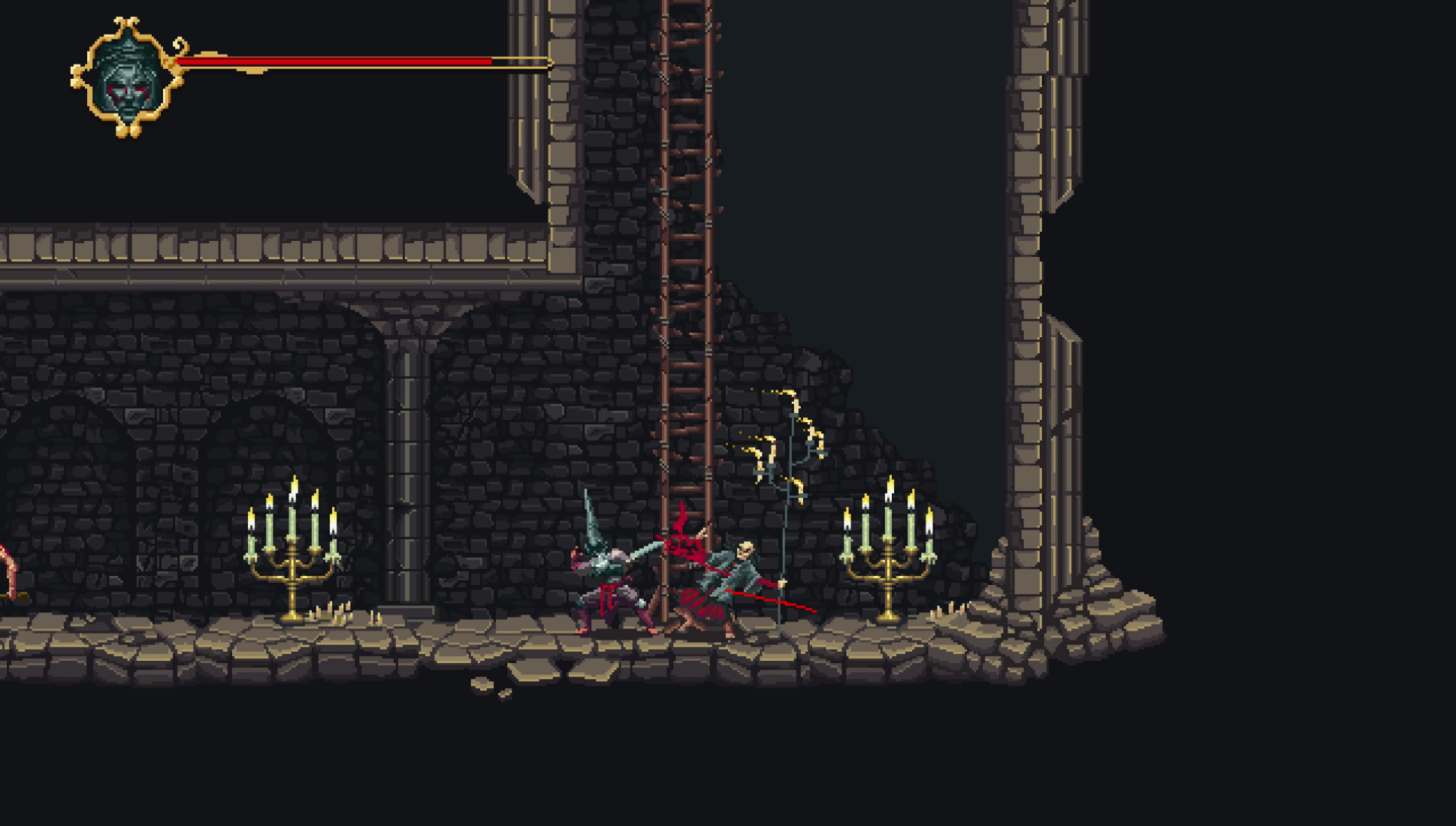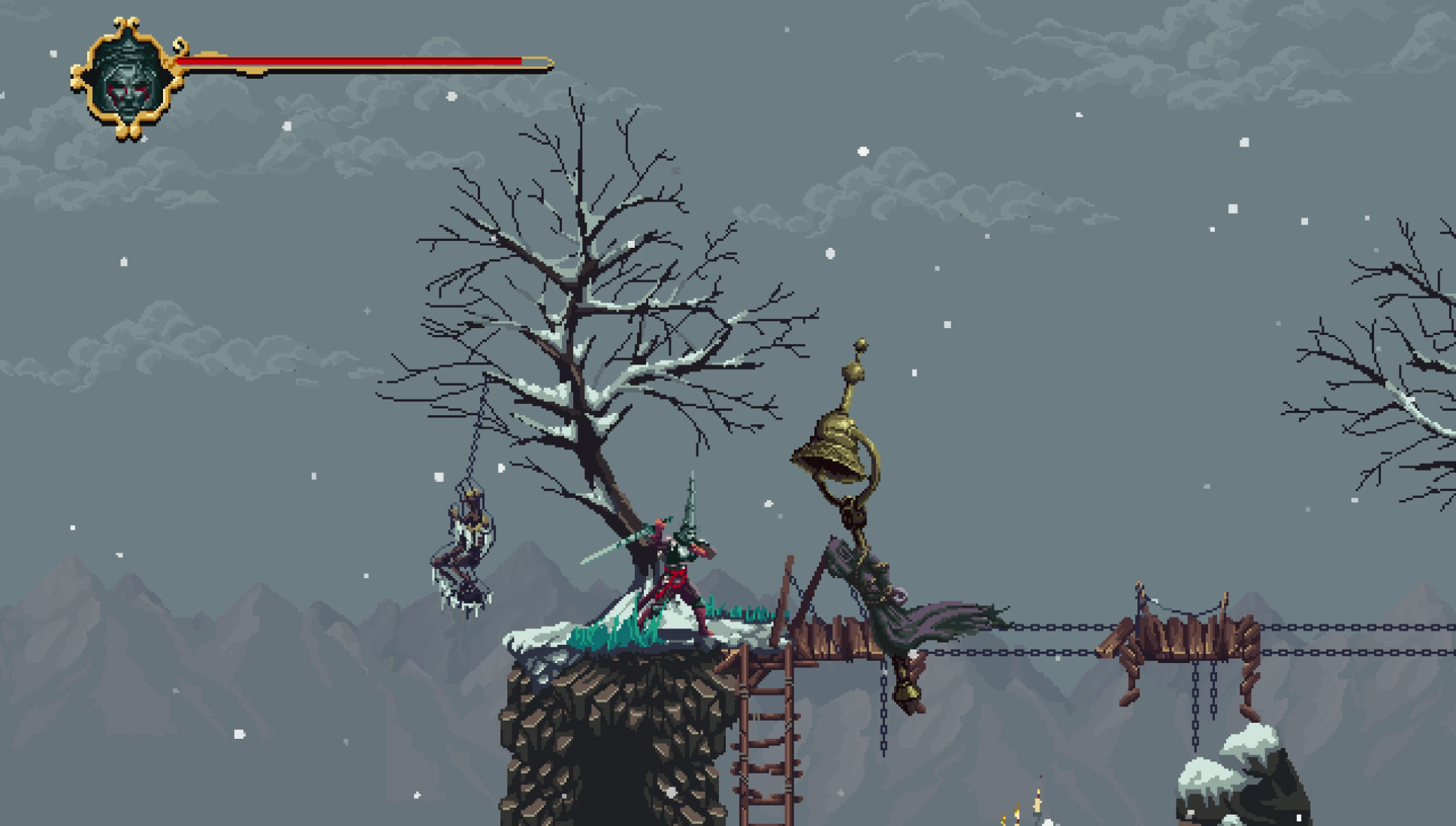Blasphemous Review – The Agony and the Ecstasy and the Even More Agony

Developed by The Game Kitchen
Published by Team17 Digital Limited
Available on PC, Xbox One, PS4, Linux, and Mac
MSRP $24.99
No intro paragraph this time, friends. We’re going right in. Blasphemous is the video game adaptation of A Procession of Flagellants by Francisco de Goya. No more, no less. You take the role of the Penitent One. A repentant knight on a divine quest, with a self-flagellating sword and an oath of silence, we can assume the quest is that of redemption. And no quest of redemption is complete without countless demonic angels that you need to kill (and be killed by). Every part of this game is about enjoying pain, and if you like getting your ass kicked, you’re in luck.
The setting for Blasphemous is an abstract hellish world. You traverse a dark gothic land where everyone seems to be a foot-washing zealot searching for their own form of self-harm. Religious iconography is everywhere. Almost every area is filled with masochistic friends and enemies. Every landscape filled with bodies and statues in pain. In fact, according to the Kickstarter page, the people of this land are cursed due to their faith. But in an interesting subversion of the trope, they are cursed not because of their lack of faith, but because they are just too gosh darn devoted for their own good and are driven insane by it.

You might be noticing a theme here. Blasphemous uses late medieval gothic style to create an incredible atmosphere, dark and disturbing. But there is a catch. As with media such as Neon Genesis, there doesn’t seem to be much direction for it. Christian symbolism in Blasphemous is just a nice blanket cast on top. Maybe it’s my own ignorance as a person who isn’t a 1500 year old Visigoth, but many of the themes and references just seem like cool looking nonsense.
There’s no way this isn’t intentional. The Game Kitchen must be aware of this, there’s so much tongue-in-cheek humor. The land you traverse is called Orthodoxia. The clinic you pass through has priests healing patients through kisses. The ultra-pious land you explore is literally indistinguishable from Hell. Blasphemous is likely a critique of blind zealotry. The Game Kitchen is a studio in Spain, a country with a history of violent religious fervor. I respect what they are trying to do, but I’m not quite sure if it works. It took me a long time for this satire to click in my head. I don’t think religious fanatics will interpret this the wrong way like some forms of satirical media (gorsh, Full Metal Jacket sure was cool. Almost makes me want to join the Marines). I just don’t think it will be recognized as such. In an almost biblical tragedy, the genius of Blasphemous is obfuscated by it’s own artistic style. Thankfully, it doesn’t need meaning to be enjoyed. While it doesn’t always seem coherent, it is nonetheless a great aesthetic and that will always take precedence.

As for the narrative of Blasphemous, right now it is completely incomprehensible to me. I’m fine with that. I don’t need the developers to chew and then vomit the story into my mouth like a little baby bird. That’s the appeal of these types of games. As with great movies, books, poetry and more, there should be plenty of room for the audience to give the story their own meaning. That’s not to say this game is without lore; indeed, there is almost too much to keep track of. Every single object you pick up has a few sentences to a paragraph of information about the world. And while many of them are interesting, the sheer volume is so overwhelming that they aren’t as memorable as the voiced lines, which are unfortunately few.
The gameplay of Blasphemous is similar to most classic Metroidvania games. Your character begins with nothing but the blessed sword in their hand and the ridiculous cone on their head. As you move through the levels, flaying both enemies and yourself, freeing cherubim and finding relics, you gradually build up new powers. I was actually impressed with the amount of interesting character modifiers available. Dozens of charms for your rosary beads raise some stats, rare spells can grant powerful buffs, as well as the occasional fountain-of-juice-that-raises-mana type objects. You know the deal. Nothing particularly innovative, but there’s really no need for it.

The combat is reminiscent of Castlevania. You start out with the standard movement, jump, dodge, and three hit combo. You know how it goes. Blasphemous introduces parrying to traditional Metroidvania combat. For some enemies it can deflect an attack leaving them open for a counter, and blocking an attack by a large enemy will prevent you from taking damage and send you sliding backward like 10 feet. One of my favorite parts of the game comes from the parrying. If you counter an enemy and they glow red, you can perform a gruesome execution unique to that enemy. Unfortunately, in practice, this was just a visual reward rather than a combat method. The glowing invitation to execute an enemy was completely random and infrequent, and more often than not, in my blind feverous attacks, I would miss the opportunity to execute them. Kind of like unsuccessfully attempting a fatality in Mortal Kombat; yes, I won, but I didn’t look cool enough.
The combat is simple enough, maybe even a bit too simple. I occasionally found myself limited by the wall climbing controls, as the button to attack is the same one as grab onto a wall. If I found myself trying to fight an enemy in the air, often I would latch onto the wall nearby, become immobile, and then get hit by whatever I was fighting. The harsh levels sometimes require precision platforming in tandem with careful combat. While this is certainly going to hit the back walls for anyone who likes a challenge, I found myself getting frustrated often. Blasphemous is forgiving in regards to dying, but this comes at a cost. In a room with say, a bunch of big swinging pendulum blades over spikes, I found myself getting stunlocked by the blades before being knocked into the pit below. And on top of having to run back through a half dozen rooms to try again, dying comes with another punishment. Rather than lose your souls and having to retrieve them, instead you lose a small chunk of your mana bar. Sure, this preferable to lost souls, but dying over and over in a room and being unable to retrieve them was maddening. Especially if the mana recovering object wound up sitting on the instant death spikes.

Even with my gripes, this game is still dope and you should try it out if you like Metroidvania games. Blasphemous stays faithful (ba dum tss) to the genre, and it works. On top of that, there’s the great aesthetic of grotesque boss fights and grand vistas of corpses and despair. And bringing it all together is some truly incredible pixel art approaching and sometimes exceeding that of a NEOGEO game. I’ll leave you with this. After killing the first boss in a sprawling room piled high with nude corpses of cone-headed knights like yourself, you stick your helmet under its flowing wound, fill it to the brim with blood, and then put the helmet back on. That’s as concise a summary as any.
Categorized:Reviews Ultra-Indie Spotlight

